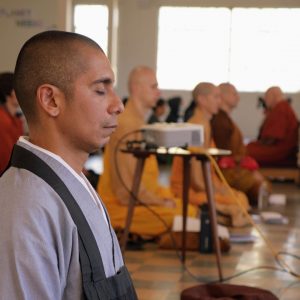
A Thread That Connects All Beings: Interview with Zenshin Dillon Balmaceda, BA ‘24, MA’ 26
Dillon Balmaceda, BA graduate of the Class of 2024 and a current MA student at DRBU, is a Zen Buddhist priest who has been practicing in the Zen tradition for nearly two decades. He also serves as a chaplain for DRBU. His spiritual journey began in his early teens during catechism classes, where he found himself questioning the teachings he received.
“When I was in my early teens, I attended catechism classes to prepare for my first communion. I remember feeling confused and disoriented, particularly by the content of Christ’s teachings. There seemed to be a lot of focus on fear, sin, and hell, but little clarity on how to relate to them besides being told that you’re sinful. I was left with the impression that, in God’s eyes, we are all sinful, but there was no clear path forward. This prompted me to ask my catechism teacher and others about the sermons and their messages, especially regarding death and fear. However, I never received a satisfactory answer. It seemed that no one had a clear understanding themselves. This experience marked the beginning of a lifelong quest for truth and meaning in my existence.”
A dynamic approach
This quest for truth led Dillon to explore various spiritual paths, eventually bringing him to a Zen monastery. There he found a dynamic approach to addressing existential questions, one that resonated deeply with him.
Speaking on his search, he says, “By my late teens, I had explored different outlets for my search for truth, including experimenting with music and traveling, which temporarily freed me from societal constraints. However, the fundamental questions about truth, life, and death persisted. This led me to investigate Eastern religions and philosophies on my own for several years. Eventually I took my spiritual investigation a step further by entering a Zen monastery, seeking a deeper understanding of these existential questions.
“When I entered the Zen monastery, I didn’t realize how significant this decision would be. The monastery opened up a new avenue for addressing my existential questions, one that resonated with a part of me that felt ancient and authentic. Instead of receiving static answers, my exploration of truth, life, and death became more dynamic and integrated with my life experiences. While these questions may never be fully answered, the process of investigating them has become a vital part of my path.”
The Start of Translation Work
Dillon’s translation work began when he encountered Dharma books translated into European Spanish. However, he found that he didn’t fully understand them because they were translated into European Spanish, a dialect different from the one he grew up with in Latin America.
This prompted him to translate the Heart Sutra into Latin American Spanish. “I chose the Heart Sutra as my first translation project due to its brevity and profound meaning. While the original text is in Sanskrit, I translated it primarily from an English translation that I felt best captured the sutra’s essence. Now, almost two decades later, when I revisit this translation, I’m pleasantly surprised to find that it still aligns with my current understanding of the text. This confirms the timeless nature of the Heart Sutra’s message and the value of my early efforts in making it more accessible to Spanish-speaking audiences.”
Making the Dharma More Accessible
Dillon calls to mind how he enjoyed the translation process and gained a deeper understanding of the text as he had to carefully examine his own understanding of the sutra and the meaning of each word. This experience made him realize that words can become lifeless if we don’t fully grasp their meaning. But when we do, they can truly come to live.
“Inspired by this realization,” he says, “I continued exploring translations and the nuances of language. Since Spanish is a Romance language known for its emotive passion, translating Dharma texts requires careful consideration to avoid becoming overly wordy. One of the challenges I’ve faced in this process is that many Sanskrit words lack accurate Spanish translations, necessitating explanations that can be time-consuming and complex. Despite these difficulties, I remain dedicated to this project, as I believe it can make Dharma teachings more accessible to Spanish speakers.”
First, Be a Practitioner
When asked what he thinks are some important things a translator needs to bear in mind while working on a task as complex as translating an ancient Buddhist text into a modern language, Dillon answers that an essential aspect of his Dharma translation practice involves maintaining awareness of his habitual tendencies.
“To breathe life into a translation, I must transcend my limited understanding and explore the depths of meaning within the words. This requires me to be a practitioner first and foremost, and secondly a translator. By doing so, I can avoid missing opportunities for deeper clarity and ensure that the translations produced are imbued with the rich wisdom of the Dharma.”
Currently, he is working on translating the Vimalakīrti Sutra. “This sutra,” he says, “delves deeply into the Buddha’s fundamental teachings, making it a significant text. Due to its importance, I am taking meticulous care in my translation work. I feel both appreciation and gratitude for the opportunity to undertake this project, despite the challenges it presents.”
A Holistic Approach to Translation
For Dillon, translation is more than a linguistic task. He has a holistic approach that enriches not only his translation work but also his entire life, as the search for meaning and connection transcends individual tasks.
“For me, translating Dharma is a spiritual practice that fuels my deep motivation for these translation projects. By reading words and endeavoring to infuse them with meaning through translation, I engage in a never-ending practice that extends beyond the act of translation itself. There is a thread that connects all beings, and the role of a translator is to locate and follow this thread to its end.”